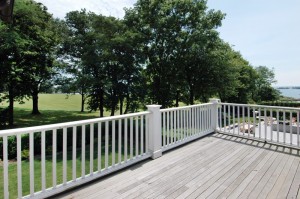Cities and towns that are privileged ( to my way of thinking) offer Historic areas, and New Rochelle is no exception. Recognized as being an Historic Distoric back in 1986, the residents have long known and appreciated what the area has to offer. Back in 2012, I had written an article about Rochelle Heights and how the original turn of the Century homes were built and sold all
It is always interesting to learn about a community, its history, and I think it also helps to understand the naming of streets, parks and the essence of a city. New Rochelle, home of the Huguenots (French Protestants) after they fled France is no different.
Imagine a water-fronted area (Davenport Neck), where glacial grooves can still be seen on the rocks, part of the Manhattan Schist formation. The grooves used to be horizontal, but now pitch almost vertically to the south. You will find pegmatite (a coarse kind of granite), quartz and feldspar which indicates that the rock cooled slowly. As a point of interest, the New Rochelle rowing club utilizes a dyke made of the same rock material on Pine Island which is just off the shore of Davenport Park. The rock formations in this area are so interesting that to the expert eye, one can see how the glaciers coursed through the area north to south many millions of years ago.
I mention the stone as it became very important to the Native Americans who would use the quartz for arrow heads. Hundreds of artifacts were found such as hammer stones, sinker stones, grooved axes, mortar and pestles, and some are on display in the Indian Room in the Thomas Paine Museum.
The clay pottery, by the way, was made by molding the clay over wicker baskets, and once dry was put into a fire to bake. It was rather crude but effective.
Henry Hudson, an Englishman, was en route to Holland and sailed up what was to be named after him, the Hudson River. The Dutch were anxious for control and to see what Hudson had discovered, and set sail up the Hudson. This trip was led by Adrian Block in 1612 and 1613. They traded with the Indians, but lost their ship to fire, and needed to build another which was called the "Onrust" (Restless). This was built in Netherland (New York City), and in 1614 set sail. They visited every corner of the lands, and they sailed north so they were the first to visit the Siwanoys, and the first to see the lands that were to be known as New Rochelle.
The Siwanoy Indians sold the land to the Dutch in 1640 in the name of the Dutch West India Company. However, under a white oak tree near the Sound on Shore Road, the Indians sold it again to Thomas Pell on November 14, 1654. One of the 6 to 8 Indians who signed this purchase was Wampage, who claimed to have killed Anne Hutchinson, and called himself Ann hoock (I have seen this written also as Annhooke as it is a translation of the native American language). I have also read that Ann hooke was someone else from another tribe (Blake Bell, Pelham Historian). While a part of Pelham, the Dutch claimed all of New Rochelle (and Pelham), and it was not relinquished until the surrender to the English by the Dutch in 1664.
The English Governor, Richard Nicholls, confirmed Pell's ownership in 1664, and he bequeathed his land to his son, John who came from England, and took up residence in Pelham. However, when the Huguenots came from France, they bought the land from Pell and started the Huguenot Settlement in New Rochelle. There is a monument listing the names of these settlers in the now Hudson Park. The Native Americans remained in the area for some years, but with the growing population of settlers, they moved further north and while there was some conflict, the Indian domination was gone.
However, one of the last remaining legacies of the Siwanoys, the Westchester Path, was originally built by the Indians and is now known as the Boston Post Road and is evidence of the original usage, and there is one last remaining milestone on the Lambden building located on the west side of Huguenot Street.
For your real estate needs, I have been living here for over 37 years, and I would love to help you.
New Rochelle is great!


Comments (0)Subscribe to CommentsComment